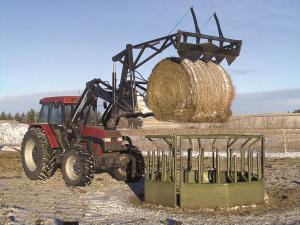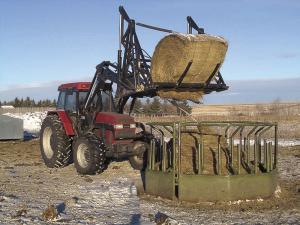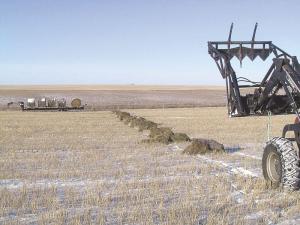2007 - Volume #31, Issue #1, Page #02
[ Sample Stories From This Issue | List of All Stories In This Issue | Print this story
| Read this issue]
On-The-Go Loader-Mounted Bale Cutter
 |
 |
 |
"I have a great view of what I'm doing without having to look back, so waste is kept to a minimum," says Schierman.
The bale cutter cuts round or large square bales of hay, silage, or straw. It has a hydraulically operated upper jaw with five large, sharpened cutting teeth that slice through the bale. The upper jaw also has a spike that extends about 8 in. beyond the center cutting tooth so that a bale can be held between the jaws without cutting it. The lower jaw has teeth that are dull and don't cut the bale or the twine.
When the jaws close, the lower half of the bale falls away and the upper half is held in the bale cutter. The spike under the teeth goes into a sheath in lower jaw so that the upper and lower teeth interlock with only a 1/8-in. gap between them.
Hooked to the tips of the retaining arms are spring-loaded cables that stretch around the cut edge of the upper half bale as the jaws close. "The cables keep the loose layers of the bale from blowing off if I'm transporting a half bale any distance when it's windy," says Schierman.
Here's how he uses the bale cutter. "Whenever it's not muddy, I use the bale cutter to drop piles of hay on the ground in a stubble field.
"When feeding round bales on the ground, I hold the bale about 6 ft. off the ground and then cut into it until a little hay falls off in a pile. Then I back up the tractor and cut into the bale some more to make another pile. I repeat this process until the jaws are closed, which makes about four piles with the first half bale. Then I lower the half bale that's still in the bale cutter to the ground and let it half way out of the jaws, so that I can pick it up again and re-cut it to make a few more piles. It takes me about three minutes to cut up an entire bale.
"When I'm done, I shut off the tractor and gather up the twine, which falls off as I go. Sometimes I'll load 10 or 12 bales onto a trailer and feed them in two different fields."
Schierman also uses the bale cutter to feed hay along a feed-through fence. "I keep the bale cutter low to the ground and cut the bale all the way through for each pile so that the piles stay fairly neat and intact. Cutting a bale into thirds or quarters makes it easier to pick up the layers with a pitchfork," he says.
He also uses the unit to cut up straw bales for bedding. He scatters the piles out with a pitchfork.
He has also used the bale cutter on large square bales. "I found that by picking large square bales up from the end, I can cut through the layers to make piles. Since the layers on a square bale aren't continuous like they are on a round bale, the hay falls off cleaner as each layer is cut. Also, if the retaining arms on the upper jaw are unbolted and taken off, the hay that would have been held inside the bale cutter can also fall off layer by layer as the jaw passes under it. This way I can convert the entire bale into piles without having to set it down to re-cut it like I do with round bales."
He built his first loader-mounted bale cutter five years ago. Two years ago he built a second, improved model and has since applied for a patent. "If anyone is interested, I'd consider building them for about $4,000 to $5,000 Canadian. I can send more photos and information to anyone who is interested. If there's a lot of interest, I'll probably look for a manufacturer," he says.
Contact: FARM SHOW Followup, Allan Schierman, P. O. Box 149, Vulcan, Alberta, Canada T0L 2B0 (ph 403 485-6714; allanschierman@yahoo.ca).

Click here to download page story appeared in.

Click here to read entire issue
To read the rest of this story, download this issue below or click here to register with your account number.




